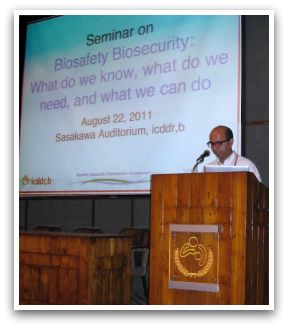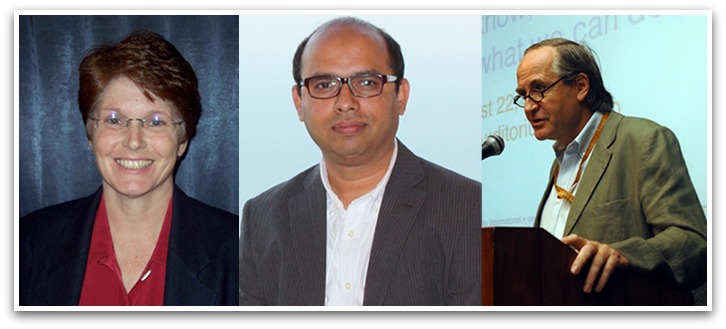Dr. Johnson, Biosafety Biosecurity International
Dr. Asadulghani & Dr. Endtz,
International Centre Diarrhoeal Disease Research, Bangladesh
Bangladesh, situated in South Asia, has a dense population supported by the rich alluvial soil along the Ganges–Brahmaputra River Delta. In recent years laboratory capacity has grown to meet the needs of diagnosing illnesses and conducting research on endemic and emerging Risk Group 3 and 4 pathogens in humans and animals. The Human Nipah virus outbreaks in Bangladesh are of particular importance since they are unlike other Nipah outbreaks; they exhibit person-to-person transmission and recur in a specific region almost annually each winter and spring. Both the International Centre Diarrhoeal Disease Research, Bangladesh (icddr,b) and the Bangladesh Institute of Epidemiology Disease Control and Research (IEDCR) work in collaboration with US Center for Disease Control teams to investigate these unique Nipah outbreaks. In addition, many tuberculosis (TB) isolates collected in Bangladesh are found to be resistant to at least one drug, and since 2005 approximately 5% show multi-drug resistance. Animal diseases are also of importance and are diagnosed and researched at the Bangladesh, Livestock Research Institute (BLRI). BLRI researches many zoonotic and endemic diseases such as B. anthracis, which can be transmitted to humans by contaminated meat — the most recent human and animal outbreak occurred in 2010-2011. Like surrounding countries, Bangladesh has reported cases of H5N1 in birds that have culminated in human infections. All of this underscores the need for appropriate containment and inventory procedures in the laboratory environment.
For these reasons, Drs. Johnson, Endtz and Asadulghani from icddr,b and Biosafety Biosecurity International partnered to address these laboratory needs with a grant from the Virtual Biosecurity Center. Our project efforts were unique as we applied a holistic approach to enhancing biosecurity and biosafety by inculcating local scientists in the ethical considerations of conducting life-sciences research and the development of codes of conducts for such research; promoting local leadership for a sustained biosecurity and biosafety presence; and laying the foundation to create a Bangladesh Biosafety and Biosecurity Association (BBBA) to promote codes of conduct and support local learning initiatives. A key factor in the long term success of this approach was our ability to pair an experienced biosafety-biosecurity professional with a regional biosafety-biosecurity champion whose mission includes training, and where the Director and biosafety officer have initiated a biosecurity and biosafety outreach program with colleagues in other local laboratories. The icddr,b has been hosting training in these disciplines over the past year and is currently the only institute in Bangladesh with a functional BSL-3 laboratory. The following is a synopsis of the project progress as of October.
 In August, icddr,b hosted a workshop attended by 155 people from 46 institutes. The workshop’s biosafety and biosecurity training occurred both in
In August, icddr,b hosted a workshop attended by 155 people from 46 institutes. The workshop’s biosafety and biosecurity training occurred both in
classroom and on-site at several local labs and (1) provided a toolkit and road map to initiate the development of the BBBA; (2) provided training for attendee’s at several laboratories on ‘how to’ assess and identify locally sustainable and appropriate solutions to biosecurity and biosafety challenges using the visited labs as models; (3) demonstrated how to implement on-the-spot solutions using procedures, developing Standard Operating Procedures and by low-cost physical means; and (4) created collaborative opportunities that were vertically integrated across Institute Directors, Ministry officials, researchers, technicians and students. During the workshop morning session, speakers from National Reference Laboratories, Universities, human and animal research laboratories and hospital clinical laboratories discussed their missions and how biosafety and biosecurity are currently being implemented at their location, what improvements are needed at their institutes, and the importance of having a national framework for biosecurity and biosafety that goes beyond legislation focusing on genetically modified organisms. During the afternoon session, presentations focused on conceptual and attainable biosecurity, bioethics, codes of conduct, and how to form a professional biosafety-biosecurity association. There was tremendous interest and enthusiasm for forming an association, and icddr,b has continued to be a leader in organizing follow-on activities, sharing a draft By Laws document with participants, and providing resources toward the establishment of a professional biosafety-biosecurity association. In addition, a second, more in-depth training was held shortly after the one-day workshop and was attended by approximately 100 individuals.
During the next days, three laboratories were visited where Drs. Johnson, Asadulghani and facility engineers had the opportunity to meet with the laboratory Director Generals, Laboratory Directors, biosafety officers and scientific staff. There were many positive aspects in each laboratory reflecting good biosafety and biosecurity practices, as well as some areas for improvement. Some of the improvements could be made immediately by using administrative solutions and implementing low/no cost procedures and training (i.e. expanding on risk assessment and mitigation and creating employee badges with pictures for enhanced access control). Other improvements would require some degree of maintenance or engineering support. In these cases the areas needing improvement were identified and their potential solutions were discussed, followed by a discussion on how well each solution would mitigate a problem. Finding appropriate local and sustainable solutions is extremely important and was a key focus in the discussions. To provide added feedback each laboratory received a detailed report regarding strengths, areas for improvement, and strategies for improvement.
Discussions between all parties in the laboratories and workshop attendees are ongoing. This project has immediately strengthened biosecurity and biosafety procedurally and physically, and is continuing to have a long-term impact through the development of a sustainable group culture of biosecurity and biosafety norms, and by facilitating and driving the development of the first national biosecurity and biosafety association in Bangladesh. Drs. Johnson, Endtz and Asadulghani thank all those involved in enhancing biosecurity and biosafety in Bangladesh through this project, and look forward to their next meeting to codify and vote on the path forward toward registering the biosafety-biosecurity association this October.





























